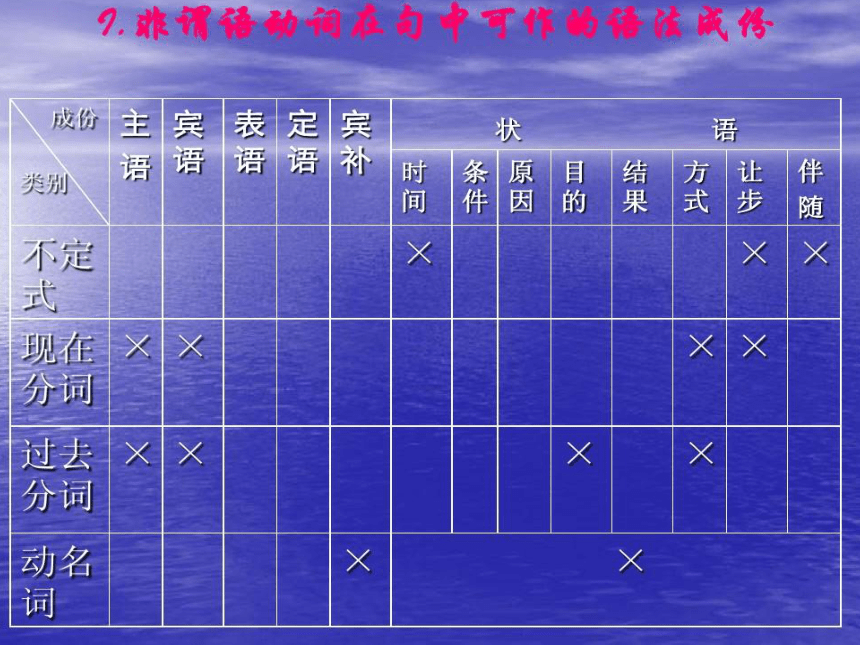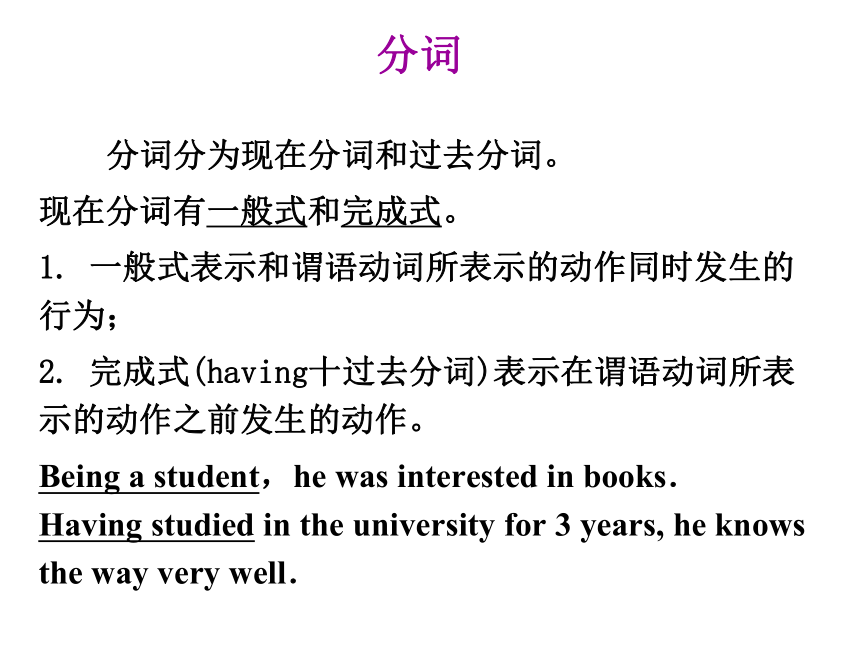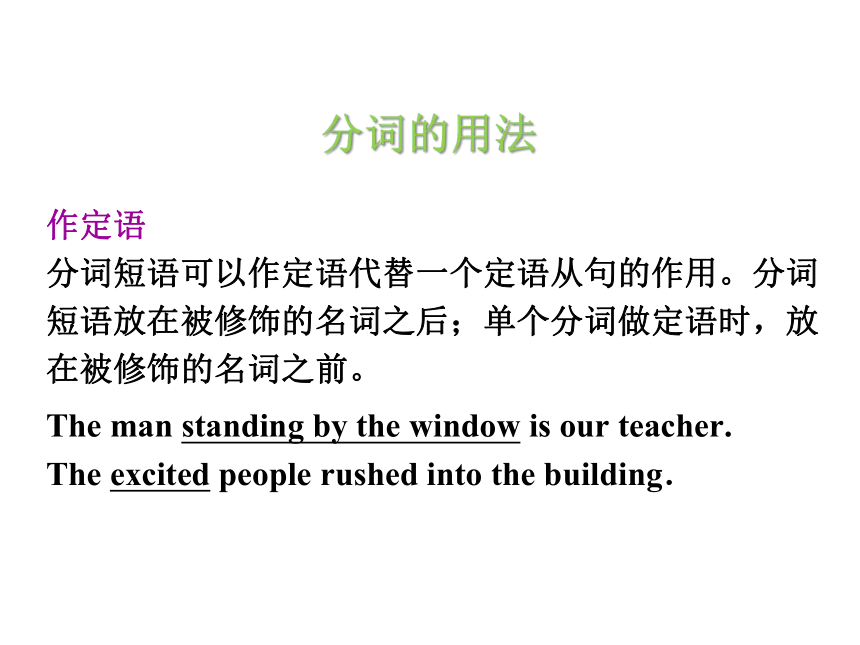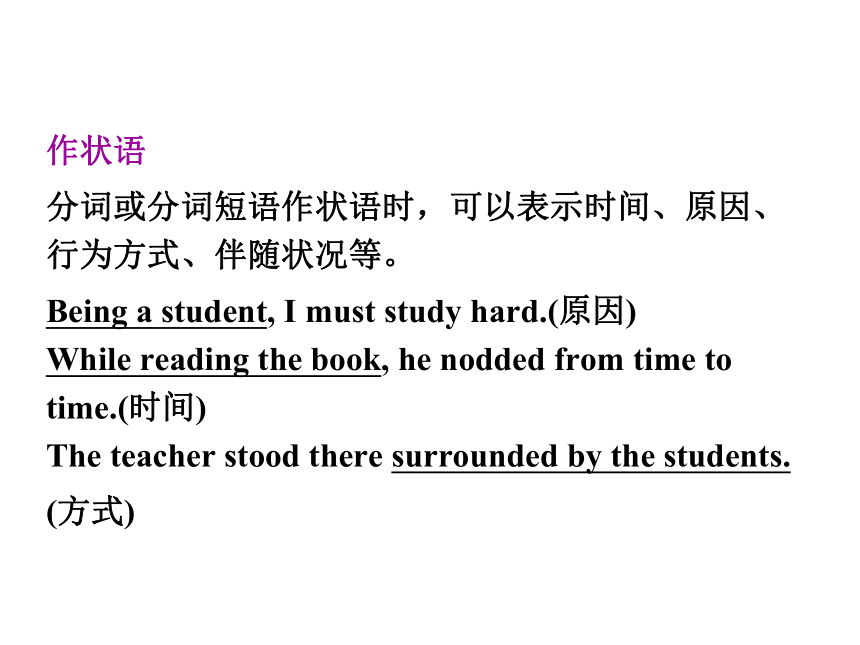外研 版高中英语选 修8Module 2 The Renaissance Review of non-finite verbs课件(共21张)
文档属性
| 名称 | 外研 版高中英语选 修8Module 2 The Renaissance Review of non-finite verbs课件(共21张) |  | |
| 格式 | zip | ||
| 文件大小 | 389.2KB | ||
| 资源类型 | 教案 | ||
| 版本资源 | 外研版 | ||
| 科目 | 英语 | ||
| 更新时间 | 2019-06-04 15:39:19 | ||
图片预览









文档简介
课件21张PPT。 Grammar
Review of non-finite verbs2019/7/29 分词 分词分为现在分词和过去分词。
现在分词有一般式和完成式。
1. 一般式表示和谓语动词所表示的动作同时发生的行为;
2. 完成式(having十过去分词)表示在谓语动词所表示的动作之前发生的动作。
Being a student,he was interested in books. Having studied in the university for 3 years, he knows the way very well. 现在分词的主动语态和被动语态当句子的主语是分词动作的承受者时,分词用被动语态,如果要强调分词的动作先于谓语动作,就用分词完成式的被动形式.
The question being discussed is important. Having been criticized by the teacher,Li Ming gave up smoking.
过去分词表示在谓语动词之前发生的动作,本身有被动的含义,所以只有一般式没有完成式。 分词的用法作定语 分词短语可以作定语代替一个定语从句的作用。分词短语放在被修饰的名词之后;单个分词做定语时,放在被修饰的名词之前。
The man standing by the window is our teacher. The excited people rushed into the building.注意: 现在分词作定语时,它表示的动作是正在进行或与谓语动词所表示的动作几乎同时发生,如果两个动作有先有后,一般不能用现在分词作定语,而要用定语从句。 The teacher criticized the student who had broken the window.作状语
分词或分词短语作状语时,可以表示时间、原因、行为方式、伴随状况等。
Being a student, I must study hard.(原因) While reading the book, he nodded from time to time.(时间) The teacher stood there surrounded by the students.
(方式) 分词短语作状语时,其逻辑主语必须与句子的主语
一致。
表示时间关系的分词短语有时可由连接词 while或
when引出。
有时“with( without)十名词(或代词宾格)十分词”
的结构,表示伴随状况。
He lay half dead,with all his ribs broken.
当分词的逻辑主语与主句的主语不同时:分词必须
有自己的主语。( 独立结构)
Time permitting, I will finish another lesson.作表语
The news is inspiring.
The glass is broken.
作宾语补足语
We saw the teacher making the experiment.注意:在 see,hear,watch,feel,observe,have,listen to,notice等动词后,既可以用现在分词构成复合宾语,也可以用不定式构成复合宾语,但两者的含义是有差别的,用现在分词,表示动作正在发生,(即处于发生的过程中,还没有结束),用不定式表示动作发生了,(即动作全过程结束了)。
I saw the girl getting on the tractor. I saw the girl get on the tractor and drive off. have +宾语+宾补 “ have+宾语+doing” 表示主体使客体处于某状态或一直在干什么事;
“ have+宾语+done”表示动作是别人做的或与主体意志无关。 The two cheats had the lights burning all night long.
He had his clothes washed.
He had his house broken into when he was away.“have + 宾语+do” 表示让某人做某事Who would you like to have go with you ?动名词 动名词由动词十 ing构成;
具有动词和名词的性质;
在句中起名词作用,可作主语、宾语、表语和定语。作主语 Seeing is believing.
Laying eggs is the ant queen’s full-time job.
It is no use arguing with him.作表语Her job is teaching.作宾语 He is fond of playing football.
I like swimming. 作定语作定语的动名词的现在分词的区分:
动名词作定语可改写成: for …结构 ,而现在分词作定语时,其主语和分词之间有逻辑上的主谓关系:
a teaching method : the method for teaching
a sleeping child: the child is sleeping 动词不定式做宾语1.某些及物动词:ask, agree, care, choose, demand, dare, decide, expect, fail, help, hope, learn, manage, offer, plan, prepare, pretend, promise, refuse, want, wish等不能用-ing形式作宾语,只能用动词不定式Tom refused to lend me his pen.2.某些及物动词:begin, start, like,love, hate, continue, prefer可用-ing也可用动词不定式作宾语I prefer to go to Paris by air.I prefer going to Paris by air.3.某些及物动词:forget, remember,try, regret, go on, mean等可用-ing也可用动词不定式作宾语,但表达的意思不同I forget to bring my homework.I forget opening the windows.4.某些动词:tell, advise, show, teach, learn, know, decide, find out等,作其宾语的动词不定式前往往加一个疑问词I don’t know how to cook.He told me how to get to the station.5.及物动词want, need, require等,当其主语是“物”时,表示“需要”,常用动词不定式的被动式作宾语Your bedroom needs to be cleaned.6. 介词后一般不直接跟动词不定式作宾语,但可用带疑问词的不定式Marx gave some advice on how
to learn English well.但but, except后可跟不定式作宾语The boss had no choice but to give in.但当主要动词是do时,to省掉They could do nothing but wait.动词不定式做定语动词不定式作定语要放在被修饰词后Have you got any questions to ask?如被修饰词和作定语的不定式没有直接的动宾关系,不定式后应有相应的介词I have no chair to sit in.当句中有不定式的逻辑主语时,作定语的动词不定式用主动形式表被动I have got a lot of things to deal with.Have you got anything to eat?当征求对方是否有事需请求者去做时,作定语的不定式一般要用被动语态“Would you please have a letter to be typed, manager?" asked the office worker.动词不定式做状语1.In order to和so as to…意义上没区别,但so as to…不能置于句首2.adj/adv+enough to…3.too+adj/adv+to…有肯定与否定The child is too young to dress
himself. 否定She is too anxious to know the
results. (ready/easy/eager/glad to)
Review of non-finite verbs2019/7/29 分词 分词分为现在分词和过去分词。
现在分词有一般式和完成式。
1. 一般式表示和谓语动词所表示的动作同时发生的行为;
2. 完成式(having十过去分词)表示在谓语动词所表示的动作之前发生的动作。
Being a student,he was interested in books. Having studied in the university for 3 years, he knows the way very well. 现在分词的主动语态和被动语态当句子的主语是分词动作的承受者时,分词用被动语态,如果要强调分词的动作先于谓语动作,就用分词完成式的被动形式.
The question being discussed is important. Having been criticized by the teacher,Li Ming gave up smoking.
过去分词表示在谓语动词之前发生的动作,本身有被动的含义,所以只有一般式没有完成式。 分词的用法作定语 分词短语可以作定语代替一个定语从句的作用。分词短语放在被修饰的名词之后;单个分词做定语时,放在被修饰的名词之前。
The man standing by the window is our teacher. The excited people rushed into the building.注意: 现在分词作定语时,它表示的动作是正在进行或与谓语动词所表示的动作几乎同时发生,如果两个动作有先有后,一般不能用现在分词作定语,而要用定语从句。 The teacher criticized the student who had broken the window.作状语
分词或分词短语作状语时,可以表示时间、原因、行为方式、伴随状况等。
Being a student, I must study hard.(原因) While reading the book, he nodded from time to time.(时间) The teacher stood there surrounded by the students.
(方式) 分词短语作状语时,其逻辑主语必须与句子的主语
一致。
表示时间关系的分词短语有时可由连接词 while或
when引出。
有时“with( without)十名词(或代词宾格)十分词”
的结构,表示伴随状况。
He lay half dead,with all his ribs broken.
当分词的逻辑主语与主句的主语不同时:分词必须
有自己的主语。( 独立结构)
Time permitting, I will finish another lesson.作表语
The news is inspiring.
The glass is broken.
作宾语补足语
We saw the teacher making the experiment.注意:在 see,hear,watch,feel,observe,have,listen to,notice等动词后,既可以用现在分词构成复合宾语,也可以用不定式构成复合宾语,但两者的含义是有差别的,用现在分词,表示动作正在发生,(即处于发生的过程中,还没有结束),用不定式表示动作发生了,(即动作全过程结束了)。
I saw the girl getting on the tractor. I saw the girl get on the tractor and drive off. have +宾语+宾补 “ have+宾语+doing” 表示主体使客体处于某状态或一直在干什么事;
“ have+宾语+done”表示动作是别人做的或与主体意志无关。 The two cheats had the lights burning all night long.
He had his clothes washed.
He had his house broken into when he was away.“have + 宾语+do” 表示让某人做某事Who would you like to have go with you ?动名词 动名词由动词十 ing构成;
具有动词和名词的性质;
在句中起名词作用,可作主语、宾语、表语和定语。作主语 Seeing is believing.
Laying eggs is the ant queen’s full-time job.
It is no use arguing with him.作表语Her job is teaching.作宾语 He is fond of playing football.
I like swimming. 作定语作定语的动名词的现在分词的区分:
动名词作定语可改写成: for …结构 ,而现在分词作定语时,其主语和分词之间有逻辑上的主谓关系:
a teaching method : the method for teaching
a sleeping child: the child is sleeping 动词不定式做宾语1.某些及物动词:ask, agree, care, choose, demand, dare, decide, expect, fail, help, hope, learn, manage, offer, plan, prepare, pretend, promise, refuse, want, wish等不能用-ing形式作宾语,只能用动词不定式Tom refused to lend me his pen.2.某些及物动词:begin, start, like,love, hate, continue, prefer可用-ing也可用动词不定式作宾语I prefer to go to Paris by air.I prefer going to Paris by air.3.某些及物动词:forget, remember,try, regret, go on, mean等可用-ing也可用动词不定式作宾语,但表达的意思不同I forget to bring my homework.I forget opening the windows.4.某些动词:tell, advise, show, teach, learn, know, decide, find out等,作其宾语的动词不定式前往往加一个疑问词I don’t know how to cook.He told me how to get to the station.5.及物动词want, need, require等,当其主语是“物”时,表示“需要”,常用动词不定式的被动式作宾语Your bedroom needs to be cleaned.6. 介词后一般不直接跟动词不定式作宾语,但可用带疑问词的不定式Marx gave some advice on how
to learn English well.但but, except后可跟不定式作宾语The boss had no choice but to give in.但当主要动词是do时,to省掉They could do nothing but wait.动词不定式做定语动词不定式作定语要放在被修饰词后Have you got any questions to ask?如被修饰词和作定语的不定式没有直接的动宾关系,不定式后应有相应的介词I have no chair to sit in.当句中有不定式的逻辑主语时,作定语的动词不定式用主动形式表被动I have got a lot of things to deal with.Have you got anything to eat?当征求对方是否有事需请求者去做时,作定语的不定式一般要用被动语态“Would you please have a letter to be typed, manager?" asked the office worker.动词不定式做状语1.In order to和so as to…意义上没区别,但so as to…不能置于句首2.adj/adv+enough to…3.too+adj/adv+to…有肯定与否定The child is too young to dress
himself. 否定She is too anxious to know the
results. (ready/easy/eager/glad to)
